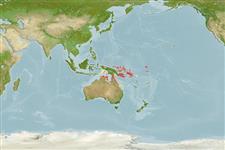>
Gobiiformes (Gobies) >
Gobiidae (Gobies) > Gobiinae
Etymology: Trimma: Greek, trimma, -atos = something crushed (Ref. 45335); meristum: Named for Christiane Waldrich, who photographed this fish; noun in the genitive case..
Environment: milieu / climate zone / depth range / distribution range
Ecologia
marino associati a barriera corallina; distribuzione batimetrica 0 - 7 m (Ref. 100726). Tropical; 1°S - 21°S, 14°E - 180°E (Ref. 100726)
Western Pacific: Australia (Great Barrier Reef), Papua New Guinea (Bismark Archipelago) and Fiji.
Size / Peso / Age
Maturity: Lm ? range ? - ? cm
Max length : 2.0 cm SL maschio/sesso non determinato; (Ref. 119492)
Short description
Morfologia | Morfometria
Spine dorsali (totale): 7; Raggi dorsali molli (totale): 8; Spine anali 1; Raggi anali molli: 7. This species is distinguished by the following characters: concave bony interorbital is less than half pupil-diameter in width; with a slight or no groove posterodorsal to the eye; scales in the midline of the predorsal 8-10; anal-fin rays 7; the fifth pelvic ray is branched twice dichotomously and subequal to the fourth in length, with a full basal membrane; the epaxial musculature reaches anteromedially to a point in line with the posterior margin of the pupil in adults; scale pockets on the head and body are strongly outlined by brown chromatophores (Ref. 100726).
Species collected from jetty pilings, log debris, and concrete stairs at the water’s edge, at about 1-4 meters. It apparently have an affinity for sponge-encrusted surfaces, but the general area where it is observed is characterized by extensive silty mud substrata inhabited by a large number of burrowing gobies. It was not previously observed despite nearly 100 hours of scuba-diving because the collection site is immediately adjacent to shore at a busy shipyard where diving is usually banned during daylight hours. Most of the specimens were found on the inner side of a single pillar of the jetty, which was situated in total shade (Ref. 119492).
Life cycle and mating behavior
Maturità | Riproduzione | Deposizione | Uova | Fecundity | Larve
Winterbottom, R. and D.F. Hoese, 2015. A revision of the Australian species of Trimma (Actinopterygii, Gobiidae), with descriptions of six new species and redescriptions of twenty-three valid species. Zootaxa 3934(1):001-102. (Ref. 100726)
IUCN Red List Status (Ref. 130435)
Threat to humans
Harmless
Human uses
Informazioni ulteriori
Nomi ComuniSinonimiMetabolismoPredatoriEcotossicologiaRiproduzioneMaturitàDeposizioneSpawning aggregationFecundityUovaEgg development
Age/SizeAccrescimentoLength-weightLength-lengthLength-frequenciesMorfometriaMorfologiaLarveDinamica popolazioni larvaliReclutamentoAbbondanzaBRUVS
BibliografiaAcquacolturaProfilo di acquacolturaVarietàGeneticaElectrophoresesEreditarietàMalattieElaborazioneNutrientsMass conversion
CollaboratoriImmaginiStamps, Coins Misc.SuoniCiguateraVelocitàModalità di nuotoArea branchialeOtolithsCervelliVista
Strumenti
Special reports
Download XML
Fonti Internet
Estimates based on models
Phylogenetic diversity index (Ref.
82804): PD
50 = 0.5000 [Uniqueness, from 0.5 = low to 2.0 = high].
Bayesian length-weight: a=0.01023 (0.00477 - 0.02194), b=3.02 (2.84 - 3.20), in cm total length, based on LWR estimates for this (Sub)family-body shape (Ref.
93245).
Resilienza (Ref.
120179): Alto, tempo minimo di raddoppiamento della popolazione meno di 15 mesi (Preliminary K or Fecundity.).
Fishing Vulnerability (Ref.
59153): Low vulnerability (10 of 100).
